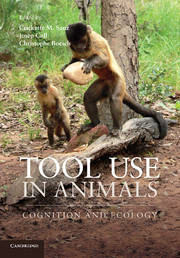Book contents
- Frontmatter
- Contents
- List of contributors
- Part I Cognition of tool use
- Part II Comparative cognition
- Part III Ecology and culture
- 8 The social context of chimpanzee tool use
- 9 Orangutan tool use and the evolution of technology
- 10 The Etho-Cebus Project: Stone-tool use by wild capuchin monkeys
- Part IV Archaeological perspectives
- Index
- References
9 - Orangutan tool use and the evolution of technology
from Part III - Ecology and culture
Published online by Cambridge University Press: 05 March 2013
- Frontmatter
- Contents
- List of contributors
- Part I Cognition of tool use
- Part II Comparative cognition
- Part III Ecology and culture
- 8 The social context of chimpanzee tool use
- 9 Orangutan tool use and the evolution of technology
- 10 The Etho-Cebus Project: Stone-tool use by wild capuchin monkeys
- Part IV Archaeological perspectives
- Index
- References
Summary
Introduction
Commonly referred to as a hallmark of human evolution, tool use is often considered a complex skill. Paradoxically, however, tool use seems to be widespread in the animal kingdom and may consist of fairly simple behavioral actions. In this chapter we try to relate these somewhat contradictory views to the relatively rare occurrence of habitual and complex tool use in wild orangutans, especially when compared to wild chimpanzees. We propose that, in addition to the previously suggested factors (i.e., extractive foraging, social tolerance and intelligence), terrestriality may have been instrumental in the evolution of especially habitual (sensu McGrew & Marchant, 1997) and complex tool use, thus explaining the “orangutan tool paradox.” Our preliminary comparison of eight orangutan and ten chimpanzee study populations (descriptively, via a principal component analysis [PCA], and by testing predictions related to the four factors) does indeed point in this direction.
Defining tool use
Although tool use has been defined in various ways (see Shumaker et al., 2011 for a detailed discussion), we choose to follow the definition of Parker and Gibson (1977):
Tool use is the manipulation of an object (the tool), not part of the actor’s anatomical equipment and not attached to a substrate, to change the position, action, or condition of another object, either directly through the action of the tool on the object or of the object on the tool, or through action at a distance as in aimed throwing.
(Modified from Parker & Gibson, 1977; Sanz & Morgan, 2007)- Type
- Chapter
- Information
- Tool Use in AnimalsCognition and Ecology, pp. 176 - 202Publisher: Cambridge University PressPrint publication year: 2013
References
- 19
- Cited by



